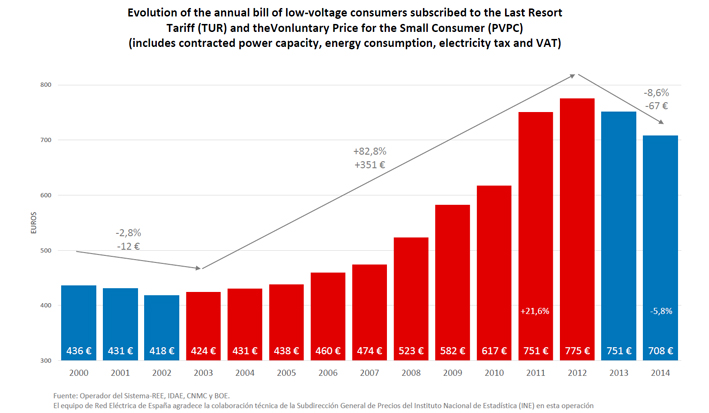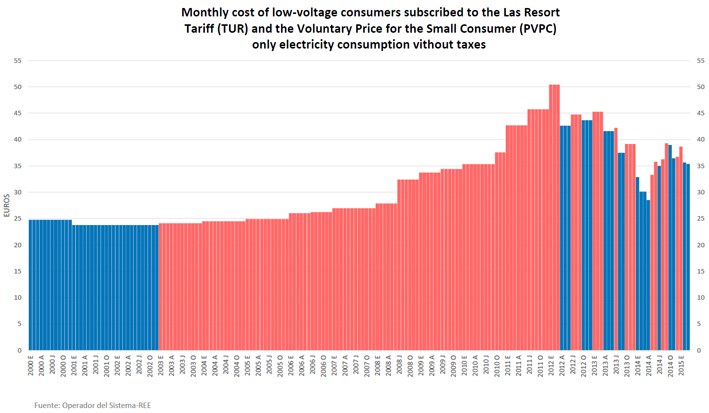For 40 years, we've been driving our country's economic and social progress. Four decades shaping Spain.
Electricity bill for low-voltage consumers fell by 5.8% in 2014
- In the last two years, the reduction has been 8.6%, with an average savings for domestic consumers of €67 per year.
The electricity bill of low-voltage consumers under the new Voluntary Price for the Small Consumer (PVPC) system fell by 5.8% in 2014, with an average bill now amounting to 708 euros per year, compared to 751 the previous year. This includes all items that are part of the electricity bill, i.e., contracted power capacity and energy consumption, electricity tax and VAT. The calculation is performed using homogeneous data, following the completion this month of the first year of validity of the PVPC; a new methodology that calculates the cost of energy production based on the day-ahead and intraday markets, among other concepts.
In the past two years, the average reduction in electricity bills has been 8.6%, with an average saving of 67 euros for a consumer signed up to the PVPC. Consumers connected at low-voltage constitute 60% of the nearly 27 million existing electricity supply contracts in Spain.
The reduction of the energy bill of 5.8% for domestic consumers in 2014 has been accompanied by the elimination of the tariff deficit that had been systematically generated every year for the last decade. According to the estimates of the National Markets and Competition Commission (CNMC) and the Ministry of Industry, Energy and Tourism, 2014 registered a slight surplus of €100 million. Additionally, for the first time since deficit began to accumulate, last year the outstanding amount payable would have gone from €24.5 billion at the end of 2013 to nearly €22 billion in 2014.
By contrast, between 2003 and 2012, the electricity bill went up an average of 82.8%. The largest increase occurred in 2011, when an increase of 21.6% was recorded, without it representing a reduction in the tariff deficit, which increased by about €5 billion.
If we consider only the electricity consumption including access tariffs, regardless of power capacity and taxes, the price of electricity started to go down three years ago, in March 2012, and since then it has seen a decline of 30% going from 50 to 35 euros/month, based on a monthly amount equivalent to 300 kWh/month.
Red Eléctrica, as operator of the Spanish electricity system calculates and publishes new electricity hourly pricing schedules as established by Royal Decree 216/2014 of 28 March 2014. The calculation of the new prices, pursuant to the methodology set by the Government, is performed by calculating the cost of energy production based on the day-ahead and intraday market, along with other concepts established in the new methodology approved by the Government.
The other concepts included are the grid access tariffs and adjustment services, if any, and other marginal costs. All this is detailed in Royal Decree 107/2014, Annex I. Red Eléctrica complies with current regulations regarding the calculation of the hourly price of electricity and provides all this information on its website as part of its transparency policy.
Price transparency
At around 8:15 pm and through website of the system operator (‘eSios’) of Red Eléctrica de España, the Company publishes the hourly prices of electricity for the next day. This service is also available via the Apple Store, through the ‘SmartVIu’ application, available also for Android. It represents the price at which the energy consumed (kWh) will be billed at to the end user.
These prices apply on the bill for all those consumers whose contracted power does not exceed 10 kW, regardless of having a smart meter with hourly metering or not. In the case a smart meter is installed, the consumer can go to the Red Eléctrica website (www.ree.es) to consult the times at which the price of electricity is lower and adapt their consumption needs to this.
If a smart meter hasn´t yet been installed, these prices will be applied in accordance to a designated consumption profile, drawn up by Red Eléctrica and which is also published weekly on the website of the system operator (‘eSios’), which is part of Red Eléctrica’s website. Consumers with a contracted power capacity of 10 to 15 kW are considered to be in the free market (free trade) and establish agreements with the companies that provide them with the service. The PVPC does not apply to them. Similarly, PVPC does not apply to consumers with less than 10 kW of contracted power who have opted for the free market. Consumers with more than 15 kW of contracted power are not considered residential, as they are usually companies.


The Press Office of Red Eléctrica publishes all written and visual information via the Twitter account @RedElectricaREE.
Also on Facebook through the account RedElectricaREE.












